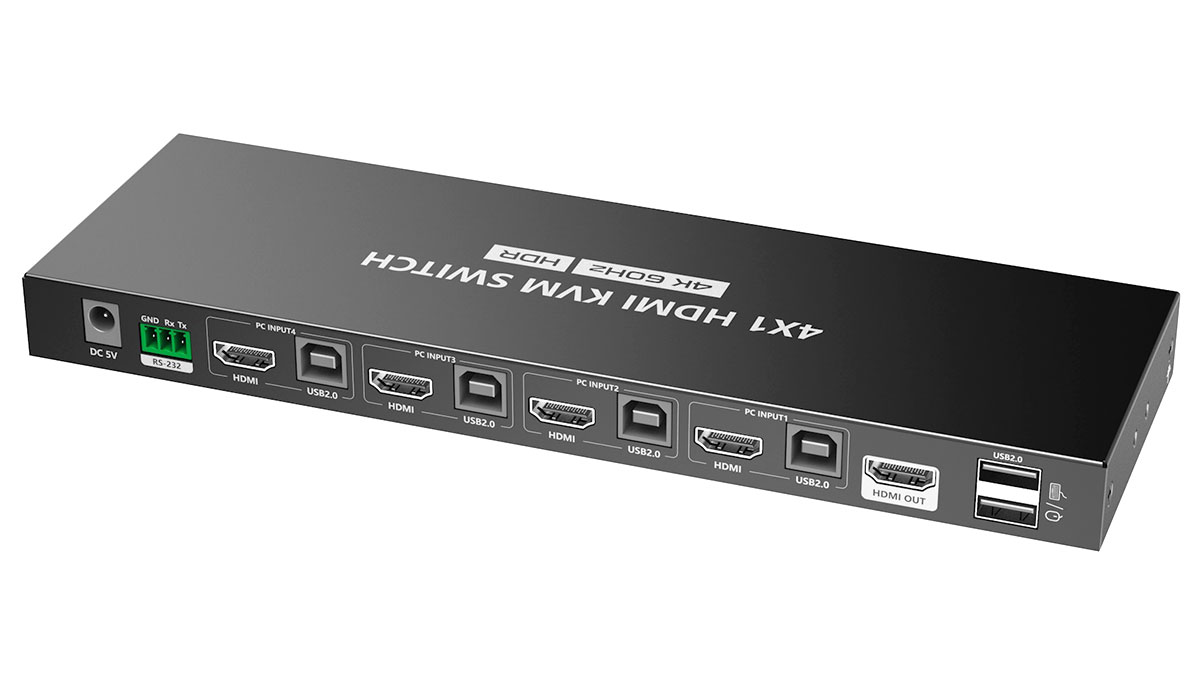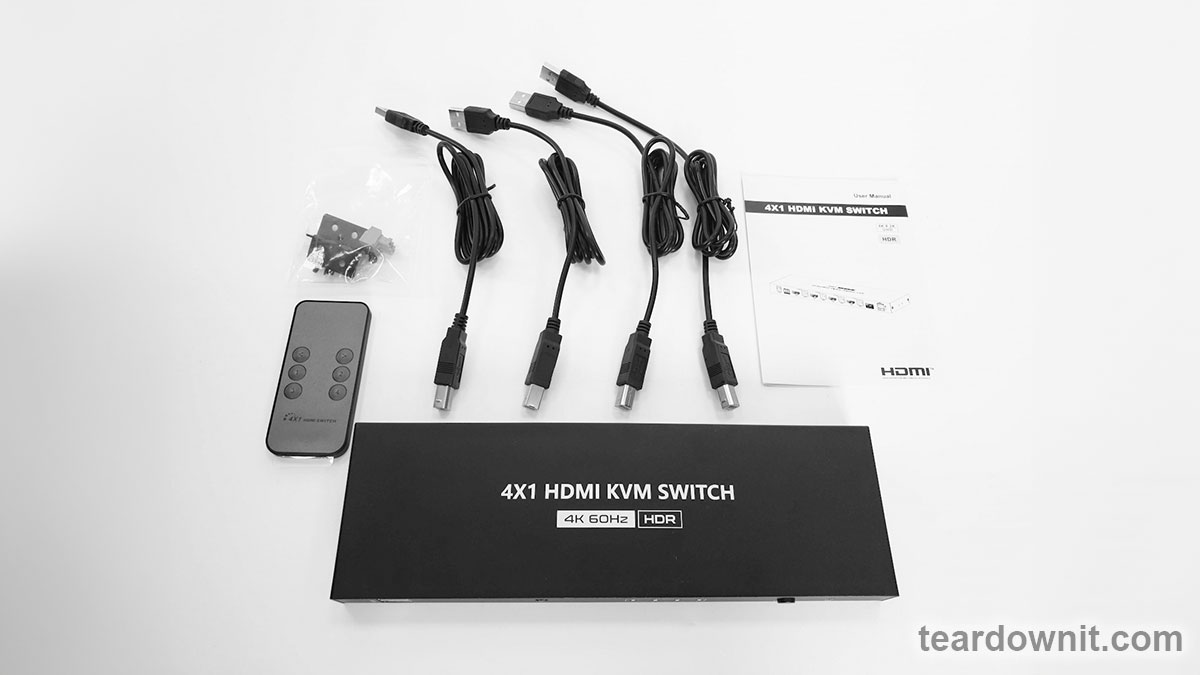Sometimes, a case exists for using multiple computers from a single desk. Several servers could be quietly grinding numbers in the background until they need to be accessed by the user for configuration or maintenance.
Sure, buying several sets of keyboards and mice is always easier. Still, it's smarter to use a specially designed unit, a KVM switch like the one we have here, the INRIKS SW4041KVM.
 Features
Features
INRIKS SW4041KVM is a 4-to-1 HDMI KVM switch. That means one can connect 4 PCs (HDMI outputs and USB ports) and one set of monitor and USB HID devices like a mouse and keyboard for the user.
This user (should we call him "operator"?) can switch from one PC to another with an IR remote or a button on the unit. This selects what computer is connected to the operator's monitor and peripherals.
In addition to these controls, there's RS232 for connecting to an external control system like Crestron.
The maximum resolution for an HDMI signal is 4K at 60 Hz.
Visual overview
INRIKS SW4041KVM is shipped in a simple cardboard box with a brief description on a sticker. The switch is carefully placed in a plastic tray, and all the accessories are under it.

The box contains:
- HDMI KVM switch
- Power supply: 5V/1A
- User manual
- IR remote
- Mounting ears and screws, 1 kit
- Grounding screw
- Terminal block for RS232
- USB A to B cables, 4 pcs

The device kit is very complete by today's standards. It includes nearly everything needed, even four USB cables. The only exception is the HDMI cable, which has to be bought separately.
The back panel has the following connection ports:
- power input, 5V
- RS232 terminal block connection
- 4 groups for PC connections, each with an HDMI input and a USB-B port
- HDMI output for the operator
- 2 USB-A ports for keyboard and mouse

Front panel
- 2 USB-A ports, just in case you need them
- IR window for the remote
- LED indicators for active input connection
- button to cycle between those inputs
- power LED

The RS-232 port allows the switch to be connected to various control systems to automate processes. The included manual has all the commands for controlling the switch from an external automation controller. Everything is clearly listed, along with the connection parameters needed.

A complete mounting kit with 2 brackets and 6 screws is also included. Those brackets are installed flush with the bottom panel of the case and are useful for mounting on a flat surface.



It is worth mentioning that the case is made of steel, and there is a grounding screw, among other accessories. So the unit can be safely installed in a server rack.
We've found that the paint is scuffed around the mounting point inside the case. This should be done intentionally to provide a better case-to-ground connection. Still, it is rather odd to do the paint scuffing manually.


Disassembling the case, we found it thick, substantial, and solid. Port cutouts are exactly where they need to be, with no shifts or bends.

Looking closely at the PCB inside, there's nothing interesting there. Everything is soldered neatly and accurately. There are a few sloppy spots on the backside, but nothing to worry about. I'm just mentioning those to be somewhat fair.


Testing
To test the INRIKS SW4041KVM switch, we prepared a set of three laptops, a monitor, a keyboard, and a mouse.

Everything's connected, and we have an image on our screen a couple seconds after powering up the switch. The mouse moves as it should; there is no input lag or video distortion. That is exactly the point of this device; one can't tell if there's an active device between the desk and the computer.
We've tried to switch inputs with the button and the remote. The only difference is that you can pick any channel with the remote, and the "SWITCH" button just cycles through them (1, 2, 3, 4, 1, 2, 3,...)

When switching inputs, there's a few seconds of delay. That is for connecting your monitor to the next PC and syncing USB devices. This behavior is normal and should be considered; it happens every time you switch HDMI inputs.
This is not a drawback for a reasonably priced device. We've tested one with instant switching before, a multiviewer 4 to 1 for CCTV applications, and it had a lower 1080p maximum resolution. In this price range, customers must pick either 4K@60 with no input lag or 4 FullHD connections simultaneously.
Then we went further and tried connecting a USB headset to our workstations. The idea is that we use those laptops for work, and we need sound devices along with a mouse and keyboard.
And the results were mixed. The headset worked except for the LED indicators for the PC connection. We suspect that the wireless base unit does not recognize our laptop, connected through the switch, as a computer for some odd reason. Apart from that, everything worked fine; the sound goes both ways.

To wrap it up, we've tried disconnecting HDMI input cables and seeing if the KVM switch works as just "KM" without "V." The third time was no charm; the switch went to standby mode. So, it switches only between active HDMI inputs and does not care if an active USB connection is plugged in.
Kinda verdict
HDMI KVM switches save space and simplify wiring for very particular cases. INRIKS SW4041KVM is an excellent device for connecting one set of peripherals to multiple computers and infrequently switching between them.
RS232 is definitely a plus to automate the switching process.
This device is intended for relatively simple professional use; if you want one at home, you can encounter issues with USB devices, as we did in our test. But if you are willing to take this risk, trying does no harm.
 teardownit
teardownit
Discussions
Become a Hackaday.io Member
Create an account to leave a comment. Already have an account? Log In.